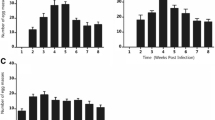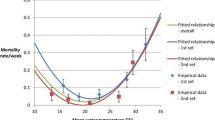Abstract
The basic hyperbolic relationship established between constant water temperatures and the length of the prepatent period in the snail was tested at diurnally fluctuating temperatures, simulating natural conditions. Diurnal temperature variations are generally summed up byS. mansoni according to the time-temperature product and are independent of the shape of the temperature curve. Using a simple hyperbolic formula, the time of prepatency can be calculated for temperatures ranging from 16° C to 32° C. The developmental rate (reciprocal of the prepatency period) within this range is a linear function of the mean environmental temperature.
Biomphalaria glabrata andS. mansoni survive well at temperature peaks as high as 40.5° C or as low as 11.5° C, if they are given as part of a diurnal sinusoidal or trapezoidal temperature programme. At fluctuating temperatures, decreasing to low values of about 11° to 14° C, however, the parasite's development was up to 27% faster than predicted. Apparently the development in the low temperature range does not follow the basic hyperbolic relationship, and even below the so-called “developmental null point” of 14.2° C some development ofS. mansoni takes place.
For practical purposes, an empirical compensation of the deviation at low temperatures is proposed. Instead of the real mean of the diurnal temperature cycle, the mean between 14.2° C and the daily maximum can be used as the basis for calculation, regardless of the time with temperatures below 14.2° C.
Similar content being viewed by others
References
Appleton CC (1977) The influence of temperature on the life-cycle and distribution ofBiomphalaria pfeifferi (Krauss, 1948) in south-eastern Africa. Int J Parsitol 7:335–345
Christensen NO, Frandsen F, Nansen P (1979) The effect of some environmental conditions and final-host- and parasite-related factors on the penetration ofSchistosoma mansoni cercariae into mice. Z. Parasitenkd 59:267–275
De Witt WB (1965) Effects of Temperature on penetration of mice by cercariae ofSchistosoma mansoni. Am J Trop Med Hyg 14:579–580
Frank GH (1966) The effect of temperature on the rate of development and emergence of schistosome cercariae. Zool Africana 2:211–221
Hoffmann KH (1980) Anpassungen im Stoffwechsel von Insekten an tagesperiodische Wechseltemperaturen. Verh Dtsch Zool Ges 1980:214–227
Laudien H (1973) Effect of temperature on processes of growth and development. In: Precht H, Christophersen J, Hensel H, Larcher W (eds) Temperature and life. Springer, Berlin Heidelberg New York, pp 355–377
Pitchford RJ, Visser PS (1965) Some further observations on schistosome transmission in the Eastern Transvaal. Bull WHO 32:83–104
Pflüger W (1978) Ecological studies in Madagascar ofBiomphalaria pfeifferi, intermediate host ofSchistosoma mansoni. 2. Biology and dynamics in the non-endemic area of Antananarivo. Arch Inst Pasteur Madagascar 46:241–269
Pflüger W (1980) Experimental epidemiology of schistosomiasis. 1. The prepatent period and cercarial production ofSchistosoma mansoni inBiomphalaria snails at various constant temperatures. Z Parasitenkd 63:159–169
Purnell RE (1966) Host-parasite relationships in schistosomiasis. 1. — The effect of temperature on the infection ofBiomphalaria sudanica tanganyicensis withSchistosoma mansoni miracidia and of laboratory mice withSchistosoma mansoni cercariae. Ann Trop Med Parasitol 60:90–93
Shiff CJ, Evans AC, Yiannakis C, Eardley M (1975) Seasonal influence on the production ofSchistosoma haematobium andS. mansoni cercariae in Rhodesia. Int J Parasitol 5:119–123
Upatham ES (1973) The effect of water temperature on the penetration and development of St. LucianSchistosoma mansoni miracidia in localBiomphalaria glabrata. Southeast Asian J Trop Med Public Health 4:367–370
Author information
Authors and Affiliations
Rights and permissions
About this article
Cite this article
Pflüger, W. Experimental epidemiology of schistosomiasis. Z. Parasitenkd. 66, 221–229 (1981). https://doi.org/10.1007/BF00925729
Received:
Issue Date:
DOI: https://doi.org/10.1007/BF00925729




